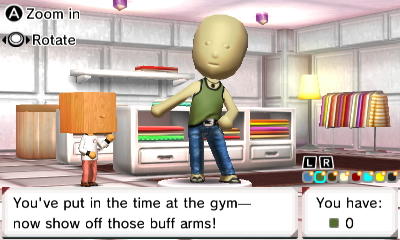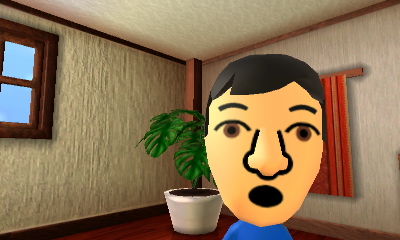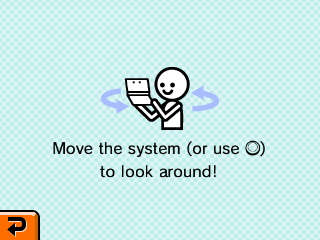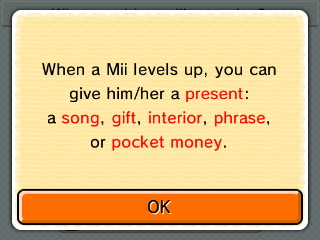Tomodachi Life keeps a social focus through a unique Japanese cultural perspective where players care for their Miis. Feeding, nursing, and entertaining are the main course on the life simulation menu here. Players’ main goal is getting their virtual person to meet that special someone while populating an island setting with their Miis – Nintendo’s current player avatars.
“Your Friends. Your Drama. Your Life.”
The Japanese word “tomodachi” means “friend” in English. The cultural aspects of this game don’t always translate as well while offering players a unique take on the life simulation game genre with plenty of room for expansion and some improvement.
The Hype
Make Miis of your favorite people and watch surprising things happen. What happens when friends, family, and celebrities become Mii characters and live on an island? Tomodachi Life—that’s what—and it’s exactly the type of crazy that memories are made of! Give Mii characters items, voices, and personalities, then watch as they rap, rock, eat donuts, fall in love, get denied, and have little Mii babies. Wait…WHAT?!
Create Mii characters, customize their voice and personality, dress them up, and decorate their apartments. Then watch as they come to life! They hang out, play concerts, engage in rap battles, hook up matchmaker-style, and even partake in cool games like Tomodachi Quest, a mini-RPG adventure. And when something really epic happens, take a picture and share it over Nintendo Image Share.* Or, send a baby Mii on a journey into your friend’s game with the StreetPass feature. Expect the unexpected because your Tomodachi Life is about to begin!
The Reality
The overall gameplay involves attitude, expressiveness, movement, and speech with focuses on personality, hunger, voice, clothing, and different personalities include independent/lone wolf, easy-going optimist, and outgoing trendsetter.
First, players create their own Mii(s) then can make special edits including allowing friends to copy the created Mii on their Nintendo 3DS or 2DS handheld game console. Only the Mii’s creator can edit the Mii. Players can save Miis by using their 3DS/2DS storage and scanning one in using the specially made QR codes. Players can obviously also grab pre-made Mii(s) from other players.
Players can share images thanks to a handy screenshot feature for either screen where players hit the x button to capture what’s on the top screen and y button for the bottom touch screen. These screen shots also lets players archive their special Mii moments into a personal photo album, so make sure the SD card has plenty of memory.
It’s fun to populate the game’s civic sites with Miis resembling people you know in real life and/or have similar personality traits as you. Players have relatively good tools to create their own celebrities who players might admire or have always wanted to know. Use a bright, well-defined picture as the base to make Miis from other subjects.
Players can customize details like glasses, freckles, height, weight, size, and shape. Players change the clothes and personality. Customization changes include several traits that focus on compatibility and can be made any time (in the town hall or apartment locations).
The sliding interfaces are nice for Mii voice editing. The Mii sound production is still very simplistic and distorted here. Sound output is far from crystal clear, which is too bad after developers give Miis the capability to say/perform what players produce and write for them.
The vocal synthesizer software sounds very robotic, which can be amusing at times, but mostly as player try to understand what the Miis are saying. Thankfully, dialogue text subtitles are an option.
Miis can perform songs complete with pre-set lyrics that are completely editable, which produces some of the funniest humor. The system does eliminate profanity to keep the game going for all ages. Developers do a great job keeping the content above-board.
The more Miis the better here. The interactions can be very fun and unique, but some are also repetitious behavior. Players have to work towards finding a spouse, since players cannot immediately start with one (no same-sex unions here) and/or children. The marriage proposal mini game amuses, while the game’s female Miis fall into more of a ranking system than the males, which might offend some players.
The Mii character development lacks a bit. Some charming things happen and the interactions among characters usually excite with possible scenarios, but there is not enough variety or expansion (in this installment anyway). Developers could have been more creative with interactions. Miis can also get part-time jobs.
Local play with two players works well (both players must have a copy of this game) plus Street Pass and Spot Pass capabilities are also included for items and other special interactions/events.
Developers also offer additional handy camera functions including a fun viewing option where players can move around their Mii’s living area. It helps players get more satisfaction from new digs and decorations plus, as always, the Mii always has interesting reactions to their new decor.
Players have some control over Mii events and interactions, which mainly depend on how each involved Mii’s personality fits with the others. It’s a decent system without any unpredictable AI.
It’s better to give and receive in Tomodachi Life. Players get paid for giving Miis food they love and must learn what works and what does not, which can be hard to tell based on other personality traits and characteristics.
Players give various items (WiiU consoles, etc.) and receive game currency back while progressing, unlocking locations/activities, and leveling characters up through the game.
The Nintendo 3DS/2DS exclusive Tomodachi Life gives the Mii more purpose in the Nintendo gaming world and creates a relatively enjoyable experience for players. Each physical game copy includes a clever “recruiting” form that players can share with two other potential players, which nets two rare panda suits in several colors for Miis to wear in the game and a demo code for other players to download and try Tomodachi Life.
Source: Reviewer copy provided by publisher
The game is $32.99 at Amazon and $34.99 at other retailers.
What I Like: Mii incorporation into gameplay, hilarious situations, interesting culture perspectives, great “sandbox” gameplay scenarios, visuals, unlimited Mii editing/customization, future potential to use developed Miis in other games, decent price
What Needs Improvement: Tomodachi Life has plenty of room for expansion, character development, more personality options, some repetitious actions












